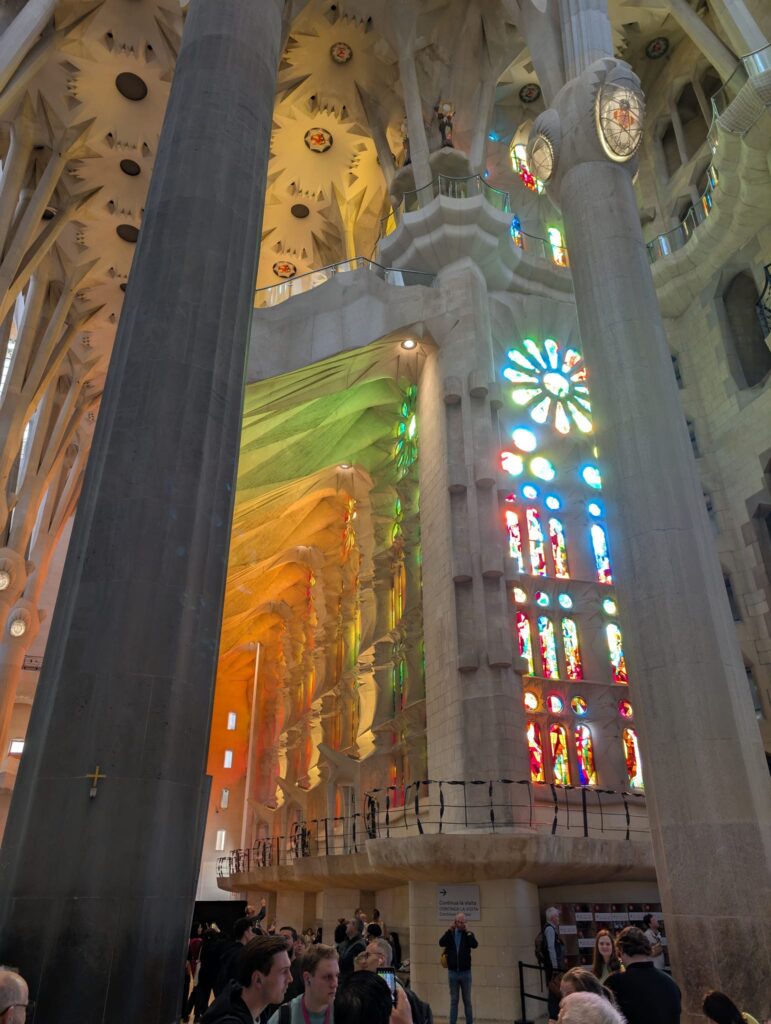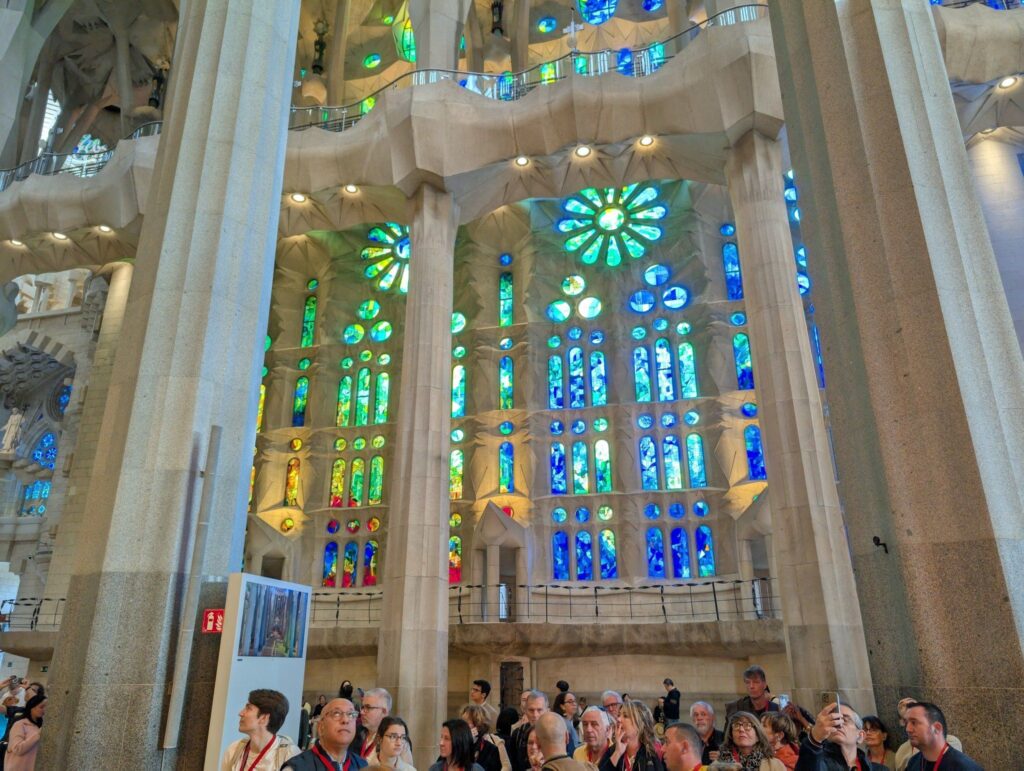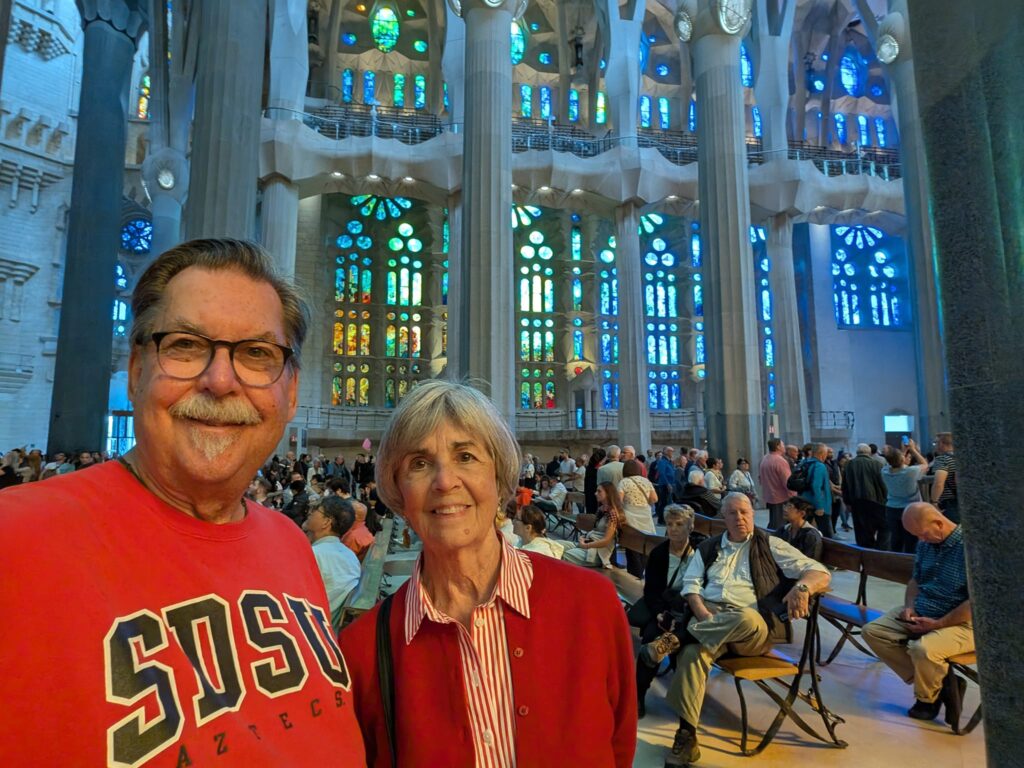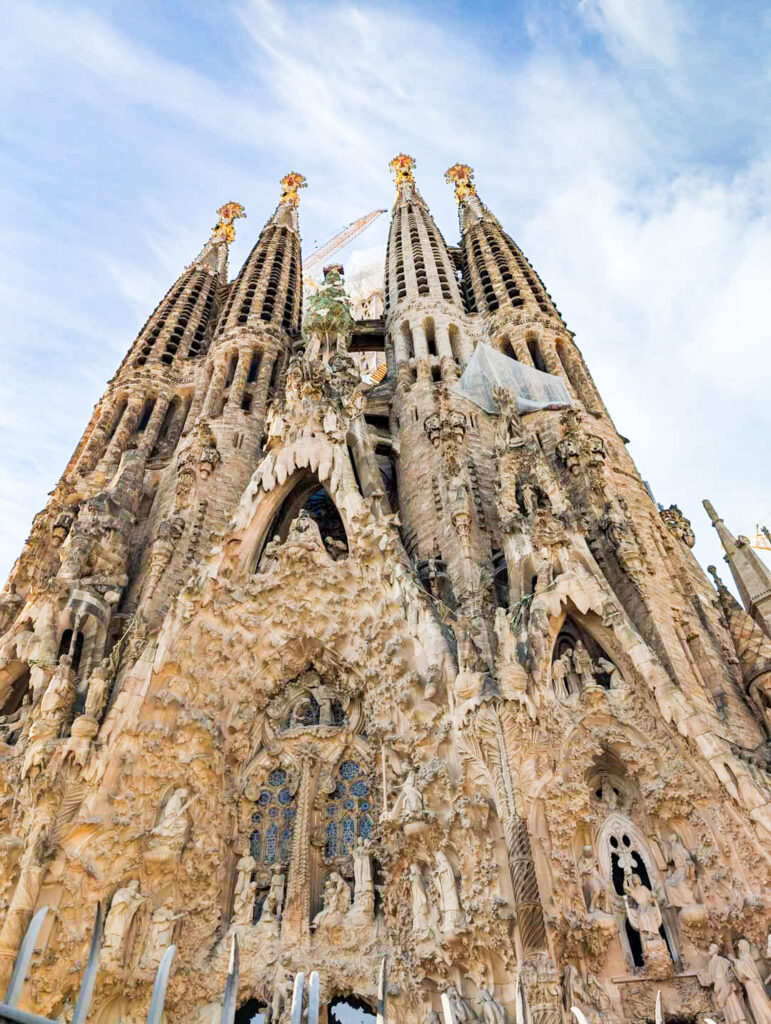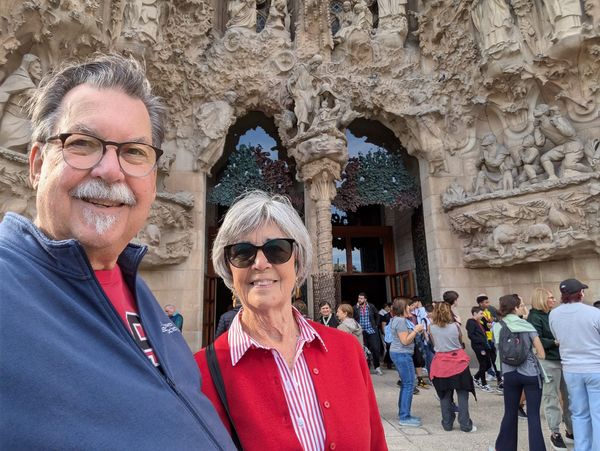For over a decade, Mary and I have watched Gaudí’s Sagrada Familia climb ever higher, gradually dominating Barcelona’s skyline. The exterior of this towering marvel—a fantasy sand sculpture of spires, statues, and stained glass—is enchanting in its own right, yet it’s the interior that truly takes your breath away. Unlike the dark, gilded cathedrals that dot Europe, Gaudí’s vision was to inspire awe rather than fear. Each element—from towering columns and text-covered doors to stained glass that cascades of rainbow-colored light throughout the sanctuary—transports visitors to a spiritual realm Gaudí wanted to share with all, believers and non-believers alike.
Construction of the Sagrada Familia began in 1882 under architect Francisco de Paula del Villar, who initially envisioned a Gothic-style structure. But when Gaudí took over just a year later, he transformed it into the unique, organic house of worship we see today. Gaudí dedicated the last 15 years of his life solely to the basilica, even living on site, yet he completed only a small fraction before his tragic death in 1926. In the years since, architects and artists have built on Gaudí’s vision with evolving styles and techniques, striving to stay in harmony with his spirit. Today, you can witness these different eras in the sculptures and facades, both inside and out.
Gaudí found inspiration in the natural world, integrating countless sculptures of plants, animals, and organic patterns into every corner of the church. The Nativity Facade, which Gaudí completed himself, celebrates Jesus’ birth with joyful scenes rich in intricate carvings of flora and fauna. In contrast, the later-built Passion Facade, created by Josep Maria Subirachs, reflects the darker, more sorrowful side of Christ’s story. Subirachs’ stark lines and angular figures evoke powerful emotions—a goal aligned with Gaudí’s vision. In a subtle tribute, Subirachs even included a figure of Gaudí himself, depicted as a bearded man with a contemplative expression, blending the architect’s likeness into the biblical narrative and honoring his dedication to the basilica.
Undaunted by the Sagrada Familia’s lengthy construction, Gaudí famously remarked, “My client is not in a hurry.” Still, modern advancements have greatly sped up the work, with the anticipated completion date now set for 2026, the centennial of Gaudí’s death. The finished basilica will boast 18 towers, including the central tower of Jesus Christ, which will rise to a height of 566 feet, making it the tallest church building in the world. This final flourish is a tribute to Gaudí’s remarkable vision, fulfilling his dream to create a work that could “inspire future generations.”
Gaudí’s commitment extended beyond design: he financed the project himself for many years and established a school on-site for the workers’ children, which is now part of the museum. This museum, along with models, plans, and an array of historical details, offers a glimpse into Gaudí’s process and the immense effort involved in continuing his work. Funding today comes from ticket sales and donations, making this a true people’s church, with services held every Sunday for locals and visitors alike.
“Gaudí’s Vision: A Timeless Journey at the Sagrada Familia”
For over a decade, Mary and I have marveled at the steady ascent of Gaudí’s Sagrada Familia, its spires climbing higher and higher to dominate Barcelona’s skyline. The exterior of this magnificent basilica—a breathtaking fusion of spires, statues, and stained glass resembling a fantastical sand sculpture—enchants visitors at first sight. Yet, it is the interior that truly leaves you speechless. Unlike the somber, gilded cathedrals scattered across Europe, Gaudí’s vision aimed to inspire awe rather than fear.
Inside, every element—from towering tree-like columns to vibrant stained glass that casts rainbow hues across the sanctuary—transports you into a spiritual realm. Gaudí’s design welcomes all, believers and non-believers alike, into a shared experience of wonder.
The story of the Sagrada Familia began in 1882 under architect Francisco de Paula del Villar, who planned a traditional Gothic-style cathedral. Just a year later, Gaudí took over, reimagining the project into the extraordinary organic masterpiece we see today. He dedicated the last 15 years of his life exclusively to this work, even living on-site, though he completed only a fraction before his untimely death in 1926. Since then, generations of architects and artists have continued Gaudí’s dream, their contributions reflecting the evolving styles and techniques of each era. Both inside and out, the basilica tells this story through its intricate sculptures, facades, and design elements.
Gaudí’s inspiration stemmed from the natural world, which he incorporated into the church through countless carvings of plants, animals, and organic forms. The Nativity Facade, completed during his lifetime, bursts with life, celebrating the joy of Christ’s birth through intricate floral and faunal designs. In contrast, the Passion Facade, built decades later by Josep Maria Subirachs, conveys the sorrow and sacrifice of Christ’s final days. Subirachs’ angular figures and stark lines evoke powerful emotions while paying homage to Gaudí’s vision. In a touching detail, Subirachs included a contemplative figure of Gaudí himself in the narrative, subtly blending the architect into the biblical story.
Gaudí famously remarked, “My client is not in a hurry,” referencing the lengthy construction timeline. Thanks to modern advancements, however, the basilica is now on track for completion by 2026, the centennial of Gaudí’s death. When finished, the Sagrada Familia will feature 18 towers, including the central tower of Jesus Christ, rising to 566 feet and claiming the title of the tallest church building in the world. This final element will fulfill Gaudí’s dream to create a work that could “inspire future generations.”
Beyond architecture, Gaudí’s dedication extended to the people who worked on the basilica. He financed much of the construction himself and even built a school on-site for the workers’ children, now part of the basilica’s museum. This museum houses models, plans, and insights into Gaudí’s process, shedding light on the challenges of continuing his work over the decades. Today, funding comes from ticket sales and donations, making this a true people’s church. Weekly services welcome locals and visitors alike, preserving its spiritual purpose.
If you plan to visit, don’t be caught off guard like some of our shipmates who couldn’t secure tickets. The Sagrada Familia’s global popularity means that advance booking is essential. Tickets are available on the official website, with options for general admission, guided tours, and access to the towers. We chose a group tour, which added incredible value by connecting every detail to Gaudí’s vision and legacy.
As we left, I couldn’t help but think about the moment the basilica will finally be completed—a dream centuries in the making. In just a few more years, we hope to witness Gaudí’s masterpiece in its full glory, a true wonder of the world.
